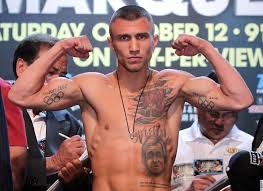Better than never (if barely): On Vasyl Lomachenko-Nicholas Walters
By Jimmy Tobin-

Saturday night, at the Cosmopolitan in Las Vegas, junior lightweight, Vasyl Lomachenko, made a quitter of Nicholas Walters in one of the most anticipated fights of last year. Walters found reasons enough in seven rounds of exposure to Lomachenko to suffer the fallout of an ignominious defeat rather than be further toyed with or worse.
Quietly ended a rivalry that would have provided greater drama had it played out at featherweight, where Walters—yet to lose a title on the scale, yet to suffer a draw a lightweight, still brimming with confidence from running roughshod over the worn and washed tributes offered to his mystique—was his most imposing. Perhaps too, had Walters not spent eleven months doing anything but fighting, doing whatever it was that made ominous the pictures of him as the weigh-in loomed, he would have mustered a better showing. Alas.
To conjure up a charitable narrative on Walter’s behalf seems like primarily the work of those embittered by the result (a Lomachenko victory even before a Walters loss). But what might they say?
Faced with a fighter near impossible to hit, it could be that Walters turned his back on his opponent, on his promoter, on a fight he never cared to participate in. Perhaps when Lomachenko unfurled his full arsenal, when he spun and struck Walters to dizzying effect in the seventh round, it was then that Walters decided that, while willing to endure 12 futile rounds he would not suffer another like the last. Maybe pride brought him to tell referee, Tony Weeks, he had no interest in fighting on, so humiliated was he by the prospect of being reduced to a sparring partner, a mere tool for practice.
Any one of these explanations is in keeping with a telling moment at the end of the fifth round. Lomachenko stood still in the center of the ring, and Walters, rather than seize the opportunity to walk Lomachenko down merely mirrored his opponent; when he did move, his first step was backward, away from Lomachenko, away, really, from any regard for the fight’s outcome. As the bell sounded to end the round, Walters simply shrugged his shoulders.
Walters had his reasons for quitting and so too will he have his consequences. The comeback trail for a fighter complicit in his defeat, a trail that already features less money and fewer television dates, is unlikely to be understanding let alone forgiving; nor, for that matter, is the collective pile-on that is the viewing public.
Underlying all of these interpretations of Walter’s conduct is Lomachenko, a generational talent, if not yet a great fighter. Fittingly, he went about his business last night in trunks and gloves patterned in a style resembling the work of pop artist, Roy Lichtenstein, who once said, “Art doesn’t transform. It plain forms.” Lomachenko is not transforming, altering, or changing his legacy so much as forming it in accordance with the ambition and talent he is endowed with. He is not held to the standards of a fighter with eight professional bouts because that would be an insult to him. And yet, it is important to keep that number in mind, because in that short span of time he has already beaten Gary Russell Jr., Rocky Martinez, and now Walters, which, while not the stuff of legend, is a feat unrivalled by any of his peers when they had less than ten fights. Even Lomachenko’s loss to Orlando Salido, which despite Salido’s manipulation of sportsmanship ended with the iron-willed Mexican on the brink, looks good.
It is not always a question of whether you win but how you do that matters, however. And while Walters must own some of the blame for the lack of fireworks Saturday night, Lomachenko’s performance was less riveting than his unmaking of Russell or his destruction of Martinez. And yet it was vintage Lomachenko (for better or worse).
Again Lomachenko erased the line between defense and offense as only he does: where punches are followed by defensive maneuvers that position him for further offense and so forth, all at the expense of opponents who are spun like flies in a spider’s web as the fatal bite closes in. Walters cocked his vaunted right hand repeatedly in the early rounds, but rarely threw it, nor did he stalk Lomachenko as he had even the most dangerous fighters he’d faced. He did not have to. Instead, Lomachenko brought the fight to Walters—and when that fight become its most intense, Walters capitulated. Here then, is the transformative element in Lomachenko’s work, best found on the bodies—in their wounds, in their language—of his opponents. Still, there are further transformations that need to take place for Lomachenko to monetize his talent.
Lomachenko’s mastery leaves some wanting more. Perhaps it is the incremental and protracted way he works, starting first with range and defense before incorporating his more hurtful—and compelling—elements of his game. Indeed, there is at least a moment or two in most all of Lomachenko’s fights where it is fair to ask why he is still fighting. He looks near flawless when he is shifting on opponents, slashing at them from improbable angles, but perhaps a little less precision, and a little more recklessness and savagery, would help him better resonate with the public. He is not a defensive fighter—his defense is a conduit for his offense—but his calculated attack understandably leaves the bloodthirsty cold.
There is a solution to his problem that requires Lomachenko make no stylistic concessions, however, one that could entrench him in a collective consciousness that extends well beyond the dwindling ranks of those who still turn to the ring for entertainment: seek out those fighters who fight with a passion you reserve only for your preparation, those fighters who carry both the hopes of a nation and a cultural obligation—and cut those men to ribbons.